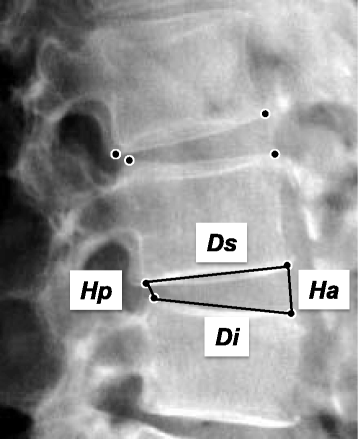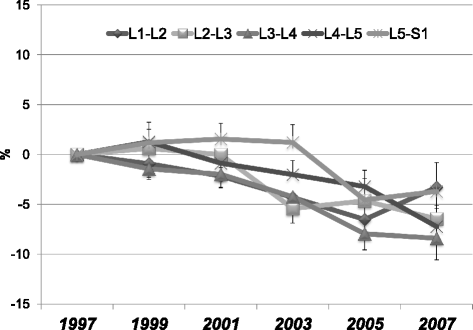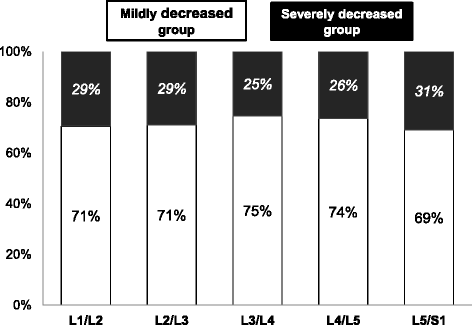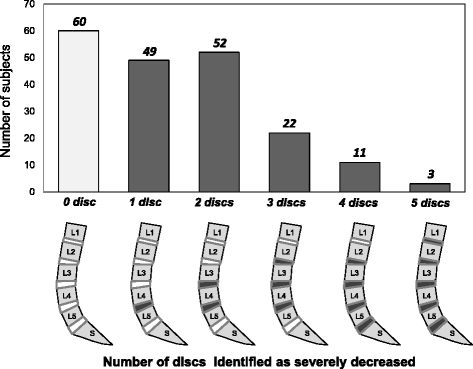Risk factors for lumbar intervertebral disc height narrowing: a population-based longitudinal study in the elderly
- PMID: 26552449
- PMCID: PMC4640385
- DOI: 10.1186/s12891-015-0798-5
Risk factors for lumbar intervertebral disc height narrowing: a population-based longitudinal study in the elderly
Abstract
Background: The progression of disc degeneration is generally believed to be associated with low back pain and/or degenerative lumbar diseases, especially in the elderly. The purpose of this study was to quantitatively evaluate changes in lumbar disc height using radiographic measurements and to investigate risk factors for development of disc height narrowing of the elderly.
Methods: From 1997 to 2007, 197 village inhabitants at least 65 years-old who participated in baseline examinations and more than four follow-up examinations conducted every second year were chosen as subjects for this study. Using lateral lumbar spine radiographs of each subject, L1-L2 to L5-S1 disc heights were measured. The subjects were divided into two groups according to the rate of change in disc height: mildly decreased (≤20 % decrease) and severely decreased (>20 % decrease). A stepwise multiple logistic regression analysis was used to select those factors significantly associated with disc height narrowing.
Results: Disc height at each intervertebral disc (IVD) level decreased gradually over ten years (p < 0.01, an average 5.8 % decrease of all disc levels). There was no significant difference in the rate of change in disc height among the IVD levels. Female gender, radiographic knee osteoarthritis and low back pain at baseline were associated with increased risk for disc height narrowing.
Conclusions: We conducted the first population-based cohort study of the elderly that quantitatively evaluated lumbar disc height using radiographic measurements. The risk factors identified in this study would contribute to a further understanding the pathology of disc degeneration.
Figures




Similar articles
-
The association between lumbar disc degeneration and low back pain: the influence of age, gender, and individual radiographic features.Spine (Phila Pa 1976). 2010 Mar 1;35(5):531-6. doi: 10.1097/BRS.0b013e3181aa5b33. Spine (Phila Pa 1976). 2010. PMID: 20147869
-
[Adjacent segment degeneration after lumbosacral fusion in spondylolisthesis: a retrospective radiological and clinical analysis].Acta Chir Orthop Traumatol Cech. 2010 Apr;77(2):124-30. Acta Chir Orthop Traumatol Cech. 2010. PMID: 20447355 Czech.
-
Thoracolumbar Intervertebral Disc Area Morphometry in Elderly Chinese Men and Women: Radiographic Quantifications at Baseline and Changes at Year-4 Follow-up.Spine (Phila Pa 1976). 2018 May 15;43(10):E607-E614. doi: 10.1097/BRS.0000000000002482. Spine (Phila Pa 1976). 2018. PMID: 29112101
-
Association between spinal morning stiffness and lumbar disc degeneration: the Rotterdam Study.Osteoarthritis Cartilage. 2012 Sep;20(9):982-7. doi: 10.1016/j.joca.2012.05.011. Epub 2012 Jun 12. Osteoarthritis Cartilage. 2012. PMID: 22698441
-
Risk factors for lumbar disc degeneration in high school American football players: a prospective 2-year follow-up study.Am J Sports Med. 2013 Sep;41(9):2059-64. doi: 10.1177/0363546513495173. Epub 2013 Jul 10. Am J Sports Med. 2013. PMID: 23841993
Cited by
-
Hounsfield unit correlates with intervertebral disc degeneration in premenopausal and menopausal women: a radiological study.J Orthop Surg Res. 2025 Apr 9;20(1):356. doi: 10.1186/s13018-025-05770-8. J Orthop Surg Res. 2025. PMID: 40205410 Free PMC article.
-
Evaluation of the Efficacy of Stem Cell Therapy in Animal Models of Intervertebral Disc Degeneration Based on Imaging Indicators: A Systematic Review and Meta-Analysis.Stem Cells Int. 2022 Aug 31;2022:2482653. doi: 10.1155/2022/2482653. eCollection 2022. Stem Cells Int. 2022. PMID: 36093439 Free PMC article.
-
Localization diagnosis of low back pain in a population-based study of a Japanese mountain village.PLoS One. 2023 Feb 23;18(2):e0282115. doi: 10.1371/journal.pone.0282115. eCollection 2023. PLoS One. 2023. PMID: 36821626 Free PMC article.
-
Intradiscal injection of monosodium iodoacetate induces intervertebral disc degeneration in an experimental rabbit model.Arthritis Res Ther. 2021 Dec 8;23(1):297. doi: 10.1186/s13075-021-02686-6. Arthritis Res Ther. 2021. PMID: 34876212 Free PMC article.
-
Novel elemental grading system for radiographic lumbar spondylosis in a population based-cohort study of a Japanese mountain village.PLoS One. 2022 Jun 28;17(6):e0270282. doi: 10.1371/journal.pone.0270282. eCollection 2022. PLoS One. 2022. PMID: 35763521 Free PMC article.
References
-
- Muraki S, Akune T, Oka H, En-Yo Y, Yoshida M, Saika A et al. Health-related quality of life in subjects with low back pain and knee pain in a population-based cohort study of Japanese men: the research on osteoarthritis against disability study. Spine. 2011;36(16):1312-9. doi:10.1097/BRS.0b013e3181fa60d1. - PubMed
Publication types
MeSH terms
LinkOut - more resources
Full Text Sources
Other Literature Sources

